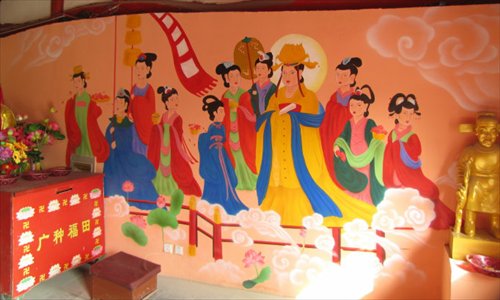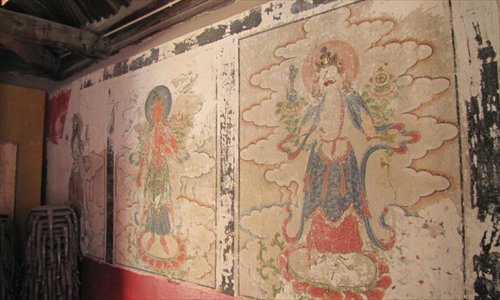Liaoning officials fired for painting over ancient fresco

The paintings that replaced the Qing Dynasty originals (below) at the Yunjie Temple in Chaoyang, Liaoning. Photos: eastday.com

The city government of Chaoyang, Liaoning Province, has fired two officials responsible for an unauthorized conservation project involving a local temple, in which an ancient fresco was painted over with modern paintings.
The Party chief of the Phoenix Mountain scenic area management office was given a warning, and the official in charge of temple affairs, together with the head of the city's cultural heritage monitoring team, were sacked, said Li Haifeng, the Chaoyang government deputy secretary-general.
A Net user, nicknamed Wujiaofeng, recently published a series of photos showing the new paintings at a hall in the Yunjie Temple in the scenic area, and compared it with the old frescos, and criticized the restoration project for destroying cultural relics.
Most buildings at the Yunjie Temple date back to the Qing Dynasty (1644-1911) and a famous pagoda in the temple was built during the Liao period (916-1125).
The painting incident occurred in a Qing Dynasty hall.
Li told the Global Times that after the incident was exposed the city government immediately carried out an investigation and issued punishments.
"Considering the temple's buildings are mainly made of straw and soil, and they need to be maintained, the abbot of the temple applied to the scenic area management office, and then the office made an application to the city's cultural heritage authority," Li said.
City authorities replied to the case, noting that the restoration should follow the national standards and procedures, and should receive approval from the provincial cultural heritage department.
However, the office did not make an application to the provincial government to get an approval before carrying out the project. The project was then carried out by a local company which was not qualified.
"The abbot found a company to start the restoration work," Li said. "The work needed about 4 million yuan ($660,000), but the temple management office did not have that much money. So the abbot helped raise funds to restore the temple."
Public angers poured in after pictures showing the artistic ancient paintings, though worn out and in broken pieces, compared with the sloppily drawn new ones in heavy colors.
Experts from the provincial cultural heritage government said the frescos can be restored to the way they looked in the past, but of course, would not be the originals.
Following the investigation, the local government will hand out further punishments.